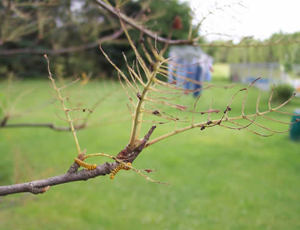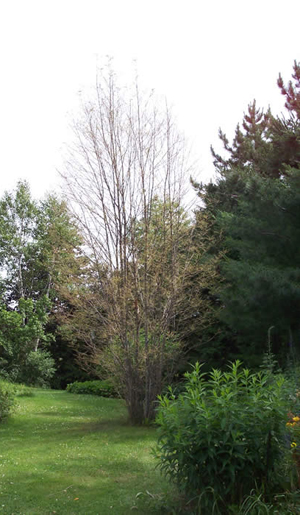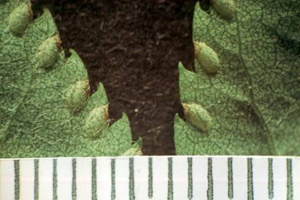DACF Home → Bureaus & Programs → Maine Forest Service → Forest Health & Monitoring → Forest Pest Index → Mountain Ash Sawfly
MOUNTAIN ASH SAWFLY
Pristiphora geniculata (Hartig)

Photo by: Kirby Ellis, Ellis’ Greenhouse and Nursery
Symptoms and Damage
The mountain ash sawfly, Pristiphora geniculata (Hartig) is a common defoliator of mountain ash in the northeastern United States and Canada. The larvae, which are yellowish green with small black spots of uneven size and shape, feed in colonies on the foliage from early June to mid-July. They straddle the leaf margin and devour all of the leaflet except the midrib. Whole branches and occasionally entire trees may be defoliated. Damage, however, is mainly to the aesthetic value of shade or ornamental trees, due to the defoliation. It seldom seriously injures trees.

Photo by: Kirby Ellis, Ellis’ Greenhouse and Nursery
Hosts
American, European, and showy mountain ash.
Life Cycle and Habits
Adult sawflies emerge in late May or early June from overwintering cocoons located in the duff and topsoil beneath trees defoliated the previous season. The egg laying device of the female sawfly is saw-like in shape; thus the common name for this insect group. Eggs are deposited singly in slits along the serrated margin of the leaflet. Adults are strong fliers and readily locate host trees even though scattered or mixed in with other hardwood species. First indication of egg deposition on the mountain ash is the presence in late May or early June of small, brown swellings along the serrated margin of the leaflet.

Photo: L.J. Lipovsky, Maine Forest Service, Forest Health & Monitoring, Slide Collection
Eggs hatch in about a week. The young larvae of the mountain ash sawfly are greenish white with head and legs black in color. The body is prominently marked with black dots except on newly-hatched larvae. Newly-hatched larvae are found from early June until early July, and reach full growth from late June to mid-July. Full grown larvae are 5/8 to 3/4 inch in length. The head and legs are yellow-orange, and the body is yellowish in color with all but the last body segment marked with small black dots of uneven size and shape. Larvae are gregarious, especially when young, and characteristically raise their body over their heads, forming an "S" shape when disturbed.
Newly-emerged larvae feed between the veins and produce a skeletonizing effect; however, shortly after, they assume the characteristic feeding position; i.e., astraddle of the leaf margin, and devour all of the leaflet except for the midrib and occasionally a few of the stronger side veins before moving on to a new leaf. Feeding is completed in about 2 to 3 weeks, after which the larvae drop to the ground and spin a cocoon in the duff or topsoil. They overwinter in the duff and emerge as adults in the spring. A small percentage of these may pupate and emerge as adults in July to start a second generation.
Control*
Hand-picking infested leaflets from small trees and destroying them is also very effective but must be done while this insect is in the egg stage or early larval stage.
A number of pesticides, including carbaryl, methoxychlor, or acephate are labeled for use against the mountain ash sawfly. These should be used as directed on the label, and apply around mid-June when first-hatched larvae are actively feeding.
*NOTE: These recommendations are not a substitute for pesticide labeling. Read the label before applying any pesticide. Pesticide recommendations are contingent on continued EPA and Maine Board of Pesticides Control registration and are subject to change.
Caution : For your own protection and that of the environment, apply the pesticide only in strict accordance with label directions and precautions.
MAINE DEPARTMENT OF AGRICULTURE, CONSERVATION AND FORESTRY
Maine Forest Service - Forest Health and Monitoring Division
April 2000